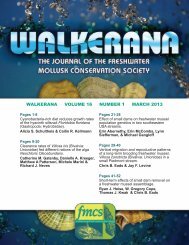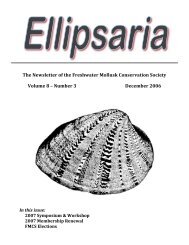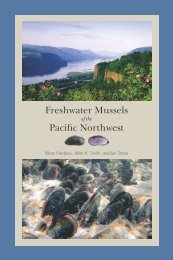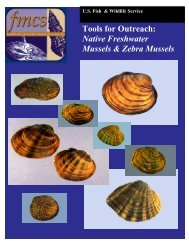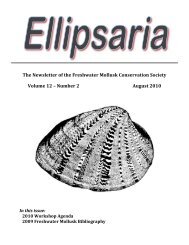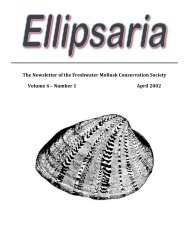August 2004 - FMCS-Freshwater Mollusk Conservation
August 2004 - FMCS-Freshwater Mollusk Conservation
August 2004 - FMCS-Freshwater Mollusk Conservation
Create successful ePaper yourself
Turn your PDF publications into a flip-book with our unique Google optimized e-Paper software.
Zoogeographical distribution on the freshwater mussels/naiades (Bivalvia:<br />
Unionoida & Veneroida) in Santa Catarina State's territory, Southern Brazil<br />
A. Ignacio Agudo<br />
Projeto Naiade (Naiade Project)<br />
Centro Integral de Educação Ambiental Cachoeira (CIEAC) (Integral Center of Environ. Education of the Waterfall),<br />
Caixa Postal (P. O. Box) 010, 88010-970 Centro, Florianópolis, Santa Catarina – SC, Brasil<br />
iagudo@lycos.com http://www.intergate.com.br/malacologia<br />
Keywords: <strong>Freshwater</strong> mussels – naiades; Unionoida; Veneroida; Continental malacological fauna survey; Santa Catarina<br />
state; Zoogeographical distribution; Southern Brazilian country.<br />
Starting from our first field registrations (Agudo 2002) to today with 20 registered species (18 natives, 2 invasive exotics),<br />
freshwater mussels/clams or naiades now represent 19% of the known mollusk continental fauna in the State of Santa Catarina<br />
(Agudo <strong>2004</strong>b), and 43% of the regional freshwater representation (Agudo <strong>2004</strong> a, f). The distribution in the State's territory<br />
includes 28 hydrographical points in the Atlantic Coastal Plains (with 12 species for 16 localities) and the Uruguay River (with<br />
16 species for 6 localities) (Agudo <strong>2004</strong> b, c), with just 8 species occurring in both systems of basins (Agudo <strong>2004</strong> b, e).<br />
Bibliographical Antecedents<br />
1.- Sudamerican River Basins<br />
Parodiz & Bonetto (1963, pp. 188, 196) present the distribution of the Naiade families Mycetopodidae and Hyriidae in<br />
South América, including the geographical Brazilian territory of Santa Catarina´s State.<br />
Bonetto (1964) revised the distribution of genus Diplodon Spix, 1827 in the southern Atlantic coastal plains basin<br />
systems, into Brazil (State of Rio de Janeiro) and the country of Uruguay.<br />
2.- Atlantic Coastal Plains Basin System<br />
Poli et al. (1978, pp. 40-41) mention the occurrence of Leila sp from the South area of “Lagoa (Pond) of Peri”, in the<br />
Santa Catarina´s Island.<br />
Simone (1994, pp. 173-174, 180) mentions Anodontites trapesialis (Lamarck, 1819) from Joinville, Rio Itapoçu and<br />
"President Vargas" (?).<br />
Agudo (2002) relates Anodontites sp., Leila blanvilliana (Lea, 1834), Mycetopoda legumen (Martens, 1888), and<br />
Eupera klappenbachi Mansur & Veitenheimer, 1975 from the hidrographical portion corresponding to Atlantic<br />
coastal plain.<br />
3.- Uruguay River Basin System<br />
Callil & Mansur (2002, pp. 154-155) mention the exotic Corbicula largillierti (Philippi, 1844) for the Municipal<br />
Districts of Joaçaba & Piratuba (Rio do Peixe), Marcelino Ramos (Uruguay River), and Corbicula fluminea (Müller,<br />
1774) for the Municipal District of Concórdia (Jacutinga River).<br />
For the upper & middle sections of the Uruguay River Basin (Brazil and Argentina), 40 species are cited in the literature<br />
(Agudo <strong>2004</strong> d); of these, 14 are confirmed/included in this registration. The occurrence of Anodontites iheringi (Clessing,<br />
1882) and Diplodon pilsbryi Marshall, 1928 in the Santa Catarina´s territory increases the species total to 42. For the<br />
remainder, the occurrence of only 5 of the 14 cited species in the historical literature for the Southern Brazilian Atlantic<br />
Coastal Plains ( Bonetto 1964; Mansur 1970, pp. 66, 74) and the Iguazu (= Iguaçu) River Basin System in the neighboring<br />
State of Paraná, to the North (Morretes 1949, pp. 17-19, 25, 30; Zanardini 1965; Parodiz 1968, pp. 4, 10), previously revised in<br />
the specialized regional literature (Mansur 1970), are confirmed in this study (Agudo <strong>2004</strong> e).<br />
Finally, another invasive exotic species, the freshwater asiatic bivalve Limnoperna fortunei (Dunker, 1857), was recently<br />
profiled with potential occurrence in the territory of the State (Mansur et al <strong>2004</strong>). Imminent entrance is awaited through the<br />
Uruguay & Iguazu River Basin Systems and, secondarily, in the “Itajaí River Basin” (through the Port of Itajaí, at the Itajaí-<br />
Açu River estuary), in the Atlantic Coastal Plain.<br />
Systematic Species List Regional Distribution<br />
Class PELECYPODA = BIVALVIA Atlantic Plains Uruguay River<br />
Order Unionoida<br />
Family MYCETOPODIDAE (8)<br />
Anodontites crispatus tenebricosus (Lea, 1834) X** X<br />
Anodontites ferrarisi (Orbigny, 1835) X<br />
Anodontites iheringi (Clessing, 1882) X<br />
Anodontites lucidus (Orbigny, 1835) X<br />
Anodontites trapesialis (Lamarck, 1819) X X<br />
20



